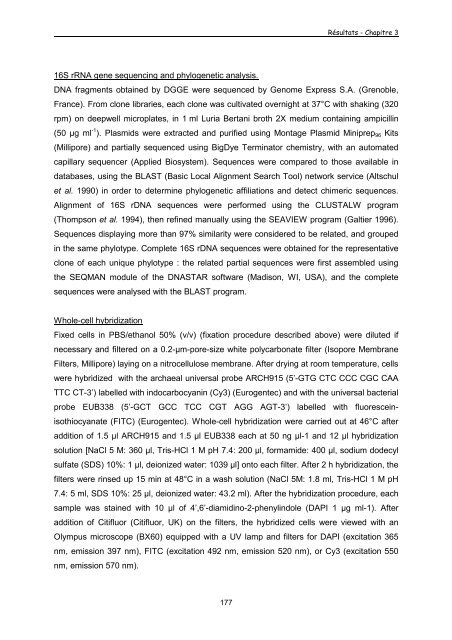THESE Anne POSTEC Diversité de populations microbiennes ...
THESE Anne POSTEC Diversité de populations microbiennes ...
THESE Anne POSTEC Diversité de populations microbiennes ...
You also want an ePaper? Increase the reach of your titles
YUMPU automatically turns print PDFs into web optimized ePapers that Google loves.
Résultats - Chapitre 3<br />
16S rRNA gene sequencing and phylogenetic analysis.<br />
DNA fragments obtained by DGGE were sequenced by Genome Express S.A. (Grenoble,<br />
France). From clone libraries, each clone was cultivated overnight at 37°C with shaking (320<br />
rpm) on <strong>de</strong>epwell microplates, in 1 ml Luria Bertani broth 2X medium containing ampicillin<br />
(50 µg ml -1 ). Plasmids were extracted and purified using Montage Plasmid Miniprep 96 Kits<br />
(Millipore) and partially sequenced using BigDye Terminator chemistry, with an automated<br />
capillary sequencer (Applied Biosystem). Sequences were compared to those available in<br />
databases, using the BLAST (Basic Local Alignment Search Tool) network service (Altschul<br />
et al. 1990) in or<strong>de</strong>r to <strong>de</strong>termine phylogenetic affiliations and <strong>de</strong>tect chimeric sequences.<br />
Alignment of 16S rDNA sequences were performed using the CLUSTALW program<br />
(Thompson et al. 1994), then refined manually using the SEAVIEW program (Galtier 1996).<br />
Sequences displaying more than 97% similarity were consi<strong>de</strong>red to be related, and grouped<br />
in the same phylotype. Complete 16S rDNA sequences were obtained for the representative<br />
clone of each unique phylotype : the related partial sequences were first assembled using<br />
the SEQMAN module of the DNASTAR software (Madison, WI, USA), and the complete<br />
sequences were analysed with the BLAST program.<br />
Whole-cell hybridization<br />
Fixed cells in PBS/ethanol 50% (v/v) (fixation procedure <strong>de</strong>scribed above) were diluted if<br />
necessary and filtered on a 0.2-µm-pore-size white polycarbonate filter (Isopore Membrane<br />
Filters, Millipore) laying on a nitrocellulose membrane. After drying at room temperature, cells<br />
were hybridized with the archaeal universal probe ARCH915 (5’-GTG CTC CCC CGC CAA<br />
TTC CT-3’) labelled with indocarbocyanin (Cy3) (Eurogentec) and with the universal bacterial<br />
probe EUB338 (5’-GCT GCC TCC CGT AGG AGT-3’) labelled with fluoresceinisothiocyanate<br />
(FITC) (Eurogentec). Whole-cell hybridization were carried out at 46°C after<br />
addition of 1.5 µl ARCH915 and 1.5 µl EUB338 each at 50 ng µl-1 and 12 µl hybridization<br />
solution [NaCl 5 M: 360 µl, Tris-HCl 1 M pH 7.4: 200 µl, formami<strong>de</strong>: 400 µl, sodium do<strong>de</strong>cyl<br />
sulfate (SDS) 10%: 1 µl, <strong>de</strong>ionized water: 1039 µl] onto each filter. After 2 h hybridization, the<br />
filters were rinsed up 15 min at 48°C in a wash solution (NaCl 5M: 1.8 ml, Tris-HCl 1 M pH<br />
7.4: 5 ml, SDS 10%: 25 µl, <strong>de</strong>ionized water: 43.2 ml). After the hybridization procedure, each<br />
sample was stained with 10 µl of 4’,6’-diamidino-2-phenylindole (DAPI 1 µg ml-1). After<br />
addition of Citifluor (Citifluor, UK) on the filters, the hybridized cells were viewed with an<br />
Olympus microscope (BX60) equipped with a UV lamp and filters for DAPI (excitation 365<br />
nm, emission 397 nm), FITC (excitation 492 nm, emission 520 nm), or Cy3 (excitation 550<br />
nm, emission 570 nm).<br />
177
















